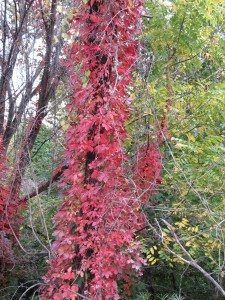Autumn foliage color is upon us in the Southern Appalachian region (USDA zones 6 and 7). On a weekend drive through the Smoky Mountains, vivid red Virginia creeper (Parthenocissus quinquefolia) foliage draped highway fences and tree branches. Virginia creeper foliage peaks 2 to 3 weeks ahead of most woodland trees and shrubs.
Lots of gardeners try to rid themselves of this aggressive vine. Yes, it’s native and frequently is misidentified as poison ivy (Toxicodendron radicans). The ¼ inch diameter bluish-black fruits are numerous and birds devour them and excrete seeds over your garden and mine.
If you need a quick cover of an ugly wall, trellis or rock pile, tendrils will “cement” themselves to almost any surface. Virginia creeper grows in any kind of soil. Seedlings grow through cracks in concrete sidewalks. The foliage of this salt tolerant vine can stabilize a sand dune on beach property. Cuttings root easily, so there is little cost to establish it.
Leaves are palmately compound, commonly 5 leaflets grouped together. Often, seed leaves start out as one, later three (mimicking poison ivy), and usually five leaflets. Its greenish white flowers are mostly inconspicuous, hidden beneath the dense glossy dark green foliage in June and July.
Overall, Virginia creeper may not be a vine to invite onto your property. Potentially, it may take over your landscape, perhaps the entire subdivision. Currently, it is a beautiful to behold in early autumn landscape.


 Posted in
Posted in 
